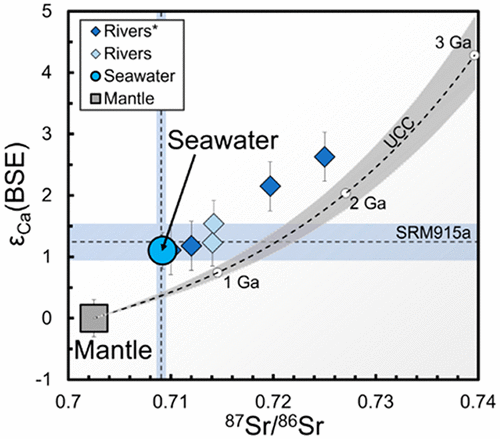当前位置:
X-MOL 学术
›
ACS Earth Space Chem.
›
论文详情
Our official English website, www.x-mol.net, welcomes your feedback! (Note: you will need to create a separate account there.)
Radiogenic 40Ca in Seawater: Implications for Modern and Ancient Ca Cycles
ACS Earth and Space Chemistry ( IF 3.4 ) Pub Date : 2021-08-27 , DOI: 10.1021/acsearthspacechem.1c00179 Michael A. Antonelli 1, 2 , Donald J. DePaolo 2, 3 , John N. Christensen 3 , Jörn-Frederik Wotzlaw 1 , Nicholas J. Pester 2, 3 , Olivier Bachmann 1
ACS Earth and Space Chemistry ( IF 3.4 ) Pub Date : 2021-08-27 , DOI: 10.1021/acsearthspacechem.1c00179 Michael A. Antonelli 1, 2 , Donald J. DePaolo 2, 3 , John N. Christensen 3 , Jörn-Frederik Wotzlaw 1 , Nicholas J. Pester 2, 3 , Olivier Bachmann 1
Affiliation

|
Radiogenic 40Ca is preferentially concentrated in the continental crust through the decay of radioactive 40K and may have the potential to be used as a tracer for Ca fluxes to the ocean through time. Numerous published flux estimates suggest that rivers are the dominant source of Ca to the oceans. This conflicts, however, with conclusions drawn from previous radiogenic Ca data suggesting that seawater Ca has been dominated by weathering/hydrothermal alteration of oceanic crust throughout Earth history. We attempt to address this discrepancy by carrying out a larger number of radiogenic Ca measurements on materials that represent modern seawater, marine carbonates, and ocean floor basalt. We find that the 40Ca/44Ca composition of the oceanic crust and mantle appear to be different from modern seawater and marine carbonates, such that the latter are measurably enriched in radiogenic 40Ca (εCa = +1.1 ± 0.3, 2SE) relative to basalts and deep-sea hydrothermal fluid. This observation is consistent with most other data available in the literature. The results are also consistent with Sr isotope data and confirm that continental sources of Ca (mainly from rivers and groundwater) dominate the modern seawater budget. We find that off-axis Ca fluxes from the low temperature alteration of the oceanic crust are not large enough to change this balance. The Ca isotope data measured and compiled here also suggest that bulk-silicate earth 40Ca/44Ca is 1.2 ± 0.3 ε-units lower than reference material SRM915a and that variations in seawater εCa in the geologic past are likely too small to be resolved with current analytical techniques.
中文翻译:

海水中的放射性 40Ca:对现代和古代 Ca 循环的影响
放射40 Ca的优先集中在通过放射性衰变大陆地壳40 K和可能有潜力被用作钙示踪剂通过时间通量到海洋。许多已发表的通量估计表明,河流是海洋中钙的主要来源。然而,这与从先前放射成因 Ca 数据得出的结论相矛盾,该结论表明海水 Ca 在整个地球历史上一直受到海洋地壳的风化/热液改变的支配。我们试图通过对代表现代海水、海洋碳酸盐和海底玄武岩的材料进行大量放射性钙测量来解决这种差异。我们发现40 Ca/ 44大洋地壳和地幔的 Ca 组成似乎与现代海水和海洋碳酸盐不同,因此后者相对于玄武岩和深海热液流体明显富含放射成因40 Ca (ε Ca = +1.1 ± 0.3, 2SE) . 这一观察结果与文献中可获得的大多数其他数据一致。结果也与 Sr 同位素数据一致,并确认大陆 Ca 的来源(主要来自河流和地下水)在现代海水收支中占主导地位。我们发现来自海洋地壳低温变化的离轴 Ca 通量不足以改变这种平衡。此处测量和汇编的 Ca 同位素数据还表明,块状硅酸盐地球40 Ca/ 44Ca 比参考材料 SRM915a 低 1.2 ± 0.3 ε-单位,并且过去地质中海水 ε Ca 的变化可能太小,无法用当前的分析技术解决。
更新日期:2021-09-16
中文翻译:

海水中的放射性 40Ca:对现代和古代 Ca 循环的影响
放射40 Ca的优先集中在通过放射性衰变大陆地壳40 K和可能有潜力被用作钙示踪剂通过时间通量到海洋。许多已发表的通量估计表明,河流是海洋中钙的主要来源。然而,这与从先前放射成因 Ca 数据得出的结论相矛盾,该结论表明海水 Ca 在整个地球历史上一直受到海洋地壳的风化/热液改变的支配。我们试图通过对代表现代海水、海洋碳酸盐和海底玄武岩的材料进行大量放射性钙测量来解决这种差异。我们发现40 Ca/ 44大洋地壳和地幔的 Ca 组成似乎与现代海水和海洋碳酸盐不同,因此后者相对于玄武岩和深海热液流体明显富含放射成因40 Ca (ε Ca = +1.1 ± 0.3, 2SE) . 这一观察结果与文献中可获得的大多数其他数据一致。结果也与 Sr 同位素数据一致,并确认大陆 Ca 的来源(主要来自河流和地下水)在现代海水收支中占主导地位。我们发现来自海洋地壳低温变化的离轴 Ca 通量不足以改变这种平衡。此处测量和汇编的 Ca 同位素数据还表明,块状硅酸盐地球40 Ca/ 44Ca 比参考材料 SRM915a 低 1.2 ± 0.3 ε-单位,并且过去地质中海水 ε Ca 的变化可能太小,无法用当前的分析技术解决。



























 京公网安备 11010802027423号
京公网安备 11010802027423号